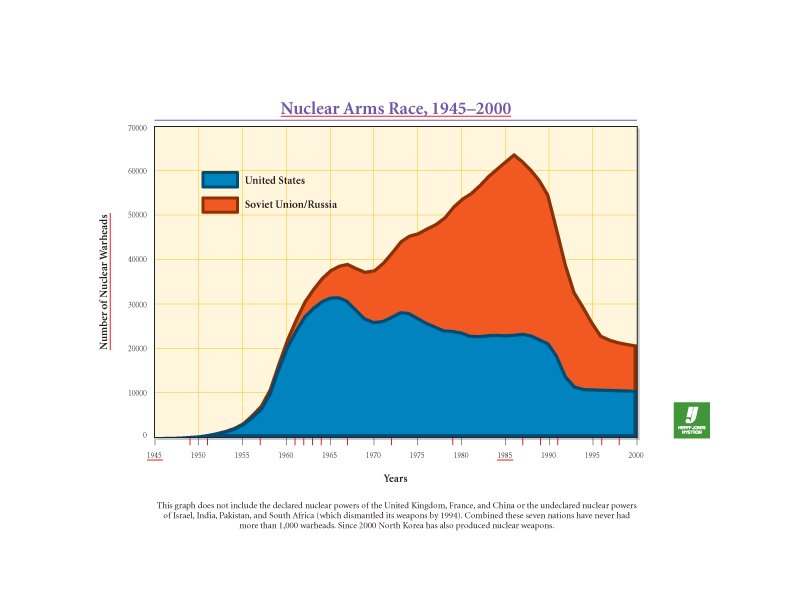
Nuclear weapons are the most destructive weapons ever created. A single fission, or atomic, bomb killed approximately 100,000 people at Hiroshima. The largest fusion, or hydrogen, bomb produced was over 3,000 times as large.
This number includes the total number of nuclear explosives, or warheads, of any size. Warheads ranged from those capable of destroying a few city blocks to those too large for any possible target. The longest-range weapons could reach any point on Earth in less than an hour.
The United States tests and uses the first nuclear weapons. The two bombs used against Japan remain the only nuclear weapons ever used against an enemy.
The Soviet Union tests its first nuclear weapon. NATO is formed. China becomes communist.
The United Kingdom tests its first nuclear weapon.
The Soviet Union launches Sputnik, the first artificial satellite. The launch also demonstrates the possibility of missiles capable of hitting any point on Earth.
Berlin Wall is built.
Cuban Missile Crisis.
The Partial Test Ban Treaty is signed, banning nuclear tests except underground. A hot line is established between Soviet and U.S. leaders to prevent misunderstandings.
The new Soviet leadership under Leonid Brezhnev begins a major nuclear weapons build-up aimed at Soviet nuclear supremacy. France and China test their first nuclear weapons.
The Non-Proliferation Treaty, limiting the spread of nuclear weapons technology, is signed by more than 40 nations, including the United States, Soviet Union, and the United Kingdom.
United States and Soviet Union agree to limit the number of nuclear weapons in the SALT I (Strategic Arms Limitation Talks) treaties. One of these treaties, the ABM Treaty, bans the development of anti-missile systems.
The SALT II treaty is rejected by the United States following the Soviet invasion of Afghanistan.
Mikhail Gorbachev becomes the Soviet leader. Tensions with the West are reduced.
The Intermediate Nuclear Force (INF) treaty eliminates a small group of nuclear weapons, mainly based in Europe.
Eastern Europe is freed from Soviet control. Berlin Wall falls.
Strategic Arms Reduction Treaty (START I) is signed, reducing the number of Soviet and American weapons. Soviet Union collapses. Russia takes control of the Soviet arsenal.
The Comprehensive Test Ban Treaty bars all nuclear tests. Most nations ratify the treaty. Notable exceptions include India, Pakistan, North Korea, Israel, Iran, Iraq, China, and the United States.
India and Pakistan conduct nuclear tests.